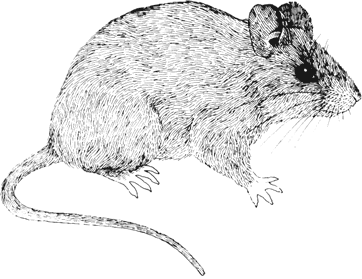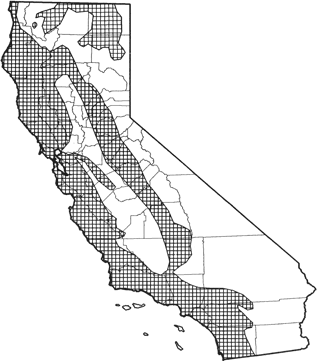
Dusky-footed Woodrat
Distribution, Abundance, and Seasonality
The dusky-footed woodrat is common in California. It is found throughout the Coast Ranges, and in the northern interior (central Siskiyou Co., Modoc Co., central to northwest Lassen Co., and northeastern Shasta Co.). Also widespread along entire western slope of the Sierra Nevada, mostly below 2150 m (7000 ft). Generally absent from cultivated land and open grasslands of Central Valley. Common to abundant in forest habitats of moderate canopy and moderate to dense understory. Can be abundant in chaparral habitats.

Range Map
Specific Habitat Requirements
Feeding: Feeds mainly on woody plants, especially live oak, maple, coffeeberry, alder, and elderberry when available (Linsdale and Tevis 1951). Other woody plants eaten elsewhere; English (1923) listed 37 species of plants eaten by the dusky-footed woodrat. Also eats fungi, flowers, grasses, acorns. Forages on ground, in bushes, and in trees.
Cover: Prefers moderate canopy in a variety of habitats. Houses are built of sticks and leaves at the base of, or in a tree, around a shrub, or at the base of a hill. Houses may measure 2.4 m (8 ft) in height and 2.4 m (8 ft) in diameter (English 1923).
Reproduction: Nests are located in the stick house, and are constructed of shredded grass, leaves, and other miscellaneous materials (e.g., bird feathers). Vestal (1938) reported the following average dimensions: 112 mm (4.4 in) x 101 mm (4 in) with a depth of 85 mm (3.4 in). Abundance probably limited by availability of nest-building materials. Competition for houses is constant and intense (Linsdale and Tevis 1951).
Water: Drinks water, but may be sustained by leafy vegetation and fungi.
Pattern: Prefers forest habitats with moderate canopy, year-round greenery, a brushy understory, and suitable nestbuilding materials. Well-developed understory at base of a single evergreen may be suitable for a single individual.
Species Life History
Activity Patterns: Mostly nocturnal. May reduce activity on moonlit or rainy nights. Active year-round.
Seasonal Movements / Migration: None.
Home Range: In Sonoma Co., home ranges averaged 0.23 ha (0.58 ac) for males, 0.19 ha (0.48 ac) for females, and 0.17 ha (0.43 ac) for juveniles; densities reached a peak of 20 individuals/ha (8/ac) in late summer (Cranford 1977). In Monterey Co., an individual may confine its lifetime activity around a single tree, or range over 18.7 ha (46.2 ac) (Linsdale and Tevis 1951). In chaparral habitat, density was reported to reach 18.8/ ha (7.5/ac) (Bleich 1973).
Territory: The nest is defended against competitors.
Reproduction: Breeds from December to September, with a peak in mid-spring. Litter size averages 2-3 young (range 1-4) (Linsdale and Tevis 1951, Verner and Boss 1980). One to 5 litters per yr. Females probably are promiscuous.
Niche: The dusky-footed woodrat is heavily preyed upon by owls, coyotes, bobcats, hawks, and perhaps snakes. Other small mammals and amphibians and reptiles are known to use woodrat houses. Cattle grazing probably reduces carrying capacity for woodrats by removing cover. Wildfires and prescribed burning are likely to be detrimental by destroying houses.
Sources & References
California Department of Fish and Game, 1999.
California's Wildlife, Sacramento, CA.
Written by: P. Brylski, reviewed by: H. Shellhammer, edited by: R. Duke
Bleich, V. C. 1973. Ecology of rodents at the United States Naval Weapon Station, Seal Beach, Fallbrook Annex, San Diego County, California. M.A. Thesis, California State Univ., Long Beach. 102pp. Cranford, J. A. 1977. Home range and habitat utilization by Neotoma fuscipes as determined by radiotelemetry. J. Mammal. 58:165-172. English, P. F. 1923. The dusky-footed woodrat (Neotoma fuscipes). J. Mammal. 4:1-9. Hooven, E. F. 1959. Dusky-footed woodrat in young Douglas-fir. Oregon For. Lands Res. Cent., Corvallis. Res. Note No. 41. 24pp. Linsdale, J. M., and L. P. Tevis, Jr. 1951. The dusky-footed woodrat. Univ. California Press, Berkeley. 664pp. Verner, J., and A. S. Boss. 1980. California wildlife and their habitats: Western Sierra Nevada. USDA, For. Serv. Gen. Tech. Rep. PSW-37. 439pp. Vestal, E. H. 1938. Biotic relations of the woodrat (Neotoma fuscipes) in the Berkeley Hills. J. Mammal. 19:1-36. Williams, D. F. 1986. Mammalian species of special concern in California. Calif. Dept. Fish and Game, Sacramento. Admin. Rep. 86-1. 112pp.
California Animal Facts | California's Wildlife